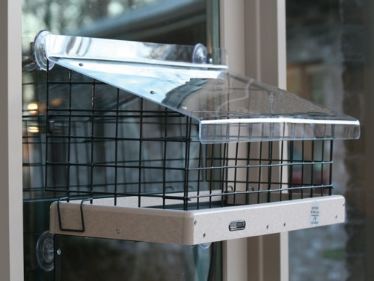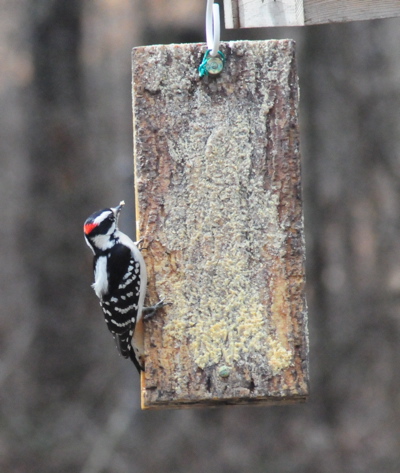-
window bird feeders to foil squirrels
 So you’d like to see feathered friends close up, but those darn squirrels always seem to find your window bird feeders! It’s an easy enough target, shimmy right on up that wall and the feast is right there for the taking. And the problem is that once they zoom in on the prize – forget it! Your seed’s a goner no matter how much is put out for the birds.
So you’d like to see feathered friends close up, but those darn squirrels always seem to find your window bird feeders! It’s an easy enough target, shimmy right on up that wall and the feast is right there for the taking. And the problem is that once they zoom in on the prize – forget it! Your seed’s a goner no matter how much is put out for the birds.Enter this nifty little accessory, the cage by BirdsChoice. The powder coat metal grid will keep larger and bully birds out, while also denying squirrels access to the seed. Get your chickadees, titmice, buntings, finches nuthatches, and more… close-up and personal!
Appearances might have it that the feeder seems too big or heavy to be stuck on the window-nonsense! Because of an innovative bracing system, and super strong suction cups, these window bird feeders are the bomb! The base is done in recycled plastic, which means it will never warp, split, crack, or fade. The non-porous surface not only makes cleaning a snap, but it helps prevent the spread of disease, as harmful bacteria can not penetrate its surface.
Filling this window bird feeder? Simple! Just lift the lid on the acrylic cover to fill with your favorite seed mix. These new window bird feeders come in two sizes, with the larger tray measuring a whopping 22 inches by 9 inches, that’s some major real estate at the window! The smaller tray (still a generous size for a window feeder) measures 11 x 10 inches. The cages and acrylic covers are relevant and proportional to each size feeder. No “one size fits all” with these high quality window bird feeders, they’re perfect for small yards or no yards at all.
-
peanut bird feeders in winter (and peanut butter)
 In our backyard there are more than enough bird feeders which accommodate many species! But when a cool feeder comes along… well, sometimes ya just can’t resist.
In our backyard there are more than enough bird feeders which accommodate many species! But when a cool feeder comes along… well, sometimes ya just can’t resist.Although the woodpeckers, nuthatches, jays and more have they’re own peanut bird feeders, we’ve found that peanut butter is also huge hit in frigid weather. And it doesn’t require a fancy feeder, or any kind feeder at all!
This innovative woodpecker feeder actually holds suet slices in between the two resin, “bark-like” panels, thus the name Suet Sandwich Feeder. On really cold days, we’ll smear peanut butter on the the outer panels as an added bonus, and the birds love it!
With the same idea, peanut butter is also fed to squirrels – smeared right on a few tree trunks in the very back of the yard. It definitely keeps them occupied and they love it too, in fact the squirrels fight over it! Loaded with fat and protein, peanut butter packs in extra calories for furry and feathered friends alike. The calories are converted to energy which help them stay warm in freezing temperatures.
Several types of common feeders may be turned into peanut bird feeders for cold weather. A standard suet cage works great for whole peanuts, platforms and dish feeders will accommodate shelled or whole peanuts, and many hoppers will take a seed mix with peanuts added to it.
Change up the ho-hum feeding routine this winter by offering peanuts or peanut butter to your beaked buddies. You won’t even need a peanut bird feeder to do it!
-
why many a glass bird feeder aren’t glass at all
 Take one classic bird feeder, craft it in solid copper, and add a circular perch… viola! You get the “Classic Copper Perch”. Yesterday a customer had inquired if the tube was glass, and to be honest, I had to open the box and inspect the feeder for the correct answer. It was not a glass bird feeder in fact, but a very thick poly-carbonate, or resin tube.
Take one classic bird feeder, craft it in solid copper, and add a circular perch… viola! You get the “Classic Copper Perch”. Yesterday a customer had inquired if the tube was glass, and to be honest, I had to open the box and inspect the feeder for the correct answer. It was not a glass bird feeder in fact, but a very thick poly-carbonate, or resin tube.Now these feeders are considered higher end, and the person seemed a bit disappointed that it was “plastic”. And me too… until I started thinking about it.
Gone are the days of cheap plastics which yellow over time (except on cheap feeders). Very few feeders and houses use real glass, for a myriad of reasons: First and foremost is breakage. Be it pesky squirrels, or even a butter fingers accident, should a glass bird
 feeder fall on concrete – it’s likely a gonner 🙁 Second: on birdhouses, glass would create an oven-like atmosphere during the heat of summer, making it too hot inside for nestlings. We feature an artist who does a wonderful fused glass birdhouse in vibrant colors, but the glass is actually fused to a real wooden nest box with proper ventilation.
feeder fall on concrete – it’s likely a gonner 🙁 Second: on birdhouses, glass would create an oven-like atmosphere during the heat of summer, making it too hot inside for nestlings. We feature an artist who does a wonderful fused glass birdhouse in vibrant colors, but the glass is actually fused to a real wooden nest box with proper ventilation.Glass bird feeders like those crafted by Parasol are mostly for hummingbirds, and the hand-blown glass seems thicker and stronger than manufactured clear glass. Same for ceramics and stoneware, it seems more durable and stronger than mass-manufactured glass.
Whatever the material of your bird feeders may be, keeping them clean is important to birds’ health. And always take precaution against Houdini squirrels… they’re brutal!
